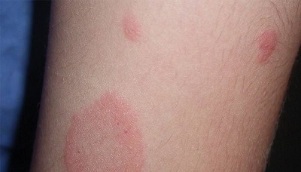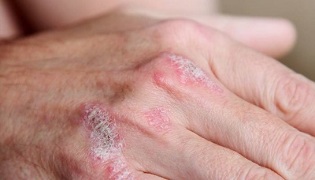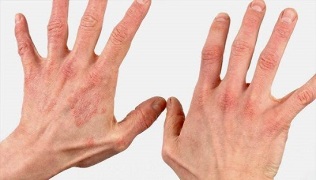A complex systemic disease that is accompanied by skin lesions is psoriasis. In a healthy body, cells live for 30-40 days and are then renewed. With the development of psoriasis, the lifespan of skin cells is 4-5 days. When they die, peeling, plaques, and dryness appear. Treating psoriasis in its early stages is always easier, so it is important not to start the disease. The therapy methods in the progressive phase differ significantly. You will read in the article only about the treatment of the initial stage of psoriasis.
Causes of the disease

In psoriasis, the work of several systems is disturbed: endocrine, immune and nervous. Until the end, doctors have not figured out the causes of this disease, nor have they invented a cure for psoriasis.
Experts propose the following hypotheses for the development of the disease:
- Viral.Retroviruses, which are inherited, can be the cause of psoriasis. Changes in the peripheral lymph nodes have been found in many patients, which may indicate the viral nature of the disease.
- Immune.With weakened immunity and impaired defense mechanisms at the cellular level, favorable conditions are created for the progression of psoriasis. Autoimmune aggression, a process by which lymphocytes begin to attack the body's own healthy cells, is also one of the causes of the disease.
- Infectious.Many researchers have looked for psoriasis pathogens. Epidermophytos, spirochetes, streptococci were suspected, but all assumptions remained false. However, scientists have found that infectious diseases: SARS, influenza, tonsillitis are a push mechanism in the development of psoriasis. In 90% of cases, this disease is accompanied by tonsillitis.
- Genetic.Psoriasis is transmitted from parents to children. 60% of patients have relatives with this skin disorder. If a mother or father is diagnosed with psoriasis, then the risk of such a disease in a child increases by 25%, if both parents are sick - by 60%.
- metabolism.Metabolic disorders (lipids, carbohydrates, vitamins, minerals) can cause psoriasis. Patients often have dysfunction of the thyroid and other glands of the endocrine system.
Main signs and symptoms
This local disease is not contagious. Skin, nails and hair are damaged. Small rashes appear on the epidermis and papules develop over time - areas of red or light pink color that protrude above the skin. From above they are covered with silver scales (plaques).

Papules may itch a little or not bother each other at all, peeling is not noticeable. Initially, the size of the affected areas of the skin is 1 to 2 millimeters, over time their size is estimated to be 10 centimeters or more.
Early-stage psoriasis: which parts of the body can be affected by the disease? The main symptoms of the disease with different localization:
- on the head.The scalp is covered with red scaly patches with many scaly scales. In this case, the hair is not involved in the pathological process. Itching is observed in patients. Skin lesions can spread to the throat and ears.
- In the face.In the initial stage, psoriasis plaques form on the skin around the eyes, on the eyelids, in the area of the nasolabial folds and eyebrows. Occasionally, psoriasis affects the lining of the mouth, cheeks, lips, tongue and, more commonly, the lip contour.
- At hand.Individual red papules appear on the palms of the hands and between the fingers. The back of the hand is affected much less often. If spots form on the fingertips, they become less sensitive over time. Psoriasis can spread to the nails.
- On the elbows.In the initial stage, individual elements of psoriasis appear, which are covered with silver scales. Then they grow into a continuously affected area of the skin from which scales and a thin film can be easily removed. After this action, the affected area turns pink in color, drops of blood appear on it.
- On my feet.The skin of the foot and the back of the leg suffers. Symptoms are similar to those seen in psoriasis of the elbows: in the initial stage, small lesions appear that grow into large areas. A symptom of blood thaw is observed.
How and how is psoriasis treated in the initial stage?

Healing psoriasis forever - how realistic is that? Unfortunately, the answer so far has been disappointing - this autoimmune disease can be corrected, but it is impossible to get rid of it completely.
Treatment of psoriasis at the initial stage gives excellent results and allows you to get rid of the visible manifestations of the pathology. Traditional medicine uses ointments, creams, solutions, therapeutic UV radiation and systemic drug treatment. There are also grandma’s remedies, but they do not give stable results.
Hypoallergenic diet
Patients with different types of psoriasis need to learn the basics of an alkaline diet. Patients need to eat foods that alkalize the internal environment. Their share should be 65-75%, part of acidic food - 25-35%.
General guidelines:
- One third of the diet consists of unprocessed vegetables and fruit. Include beets, cabbage, carrots, herbs, cucumber, onions, garlic, and celery in the menu.
- Another third of the daily menu for psoriasis is complex carbohydrates and natural sweets in limited quantities. Eat porridge (barley, buckwheat), dried fruits (raisins, dried apricots, dates).
- The last part of the diet consists of animal and vegetable proteins. Eat lean meat, fish, peas, beans, seeds, eggs, nuts. Polyunsaturated fatty acids should also be on the menu.
- Drink at least 7-10 glasses of clean water a day. Alcohol is forbidden.
- For an effective treatment, avoid citrus fruits, fatty dairy products and meat, chocolate and red products. Use honey to a minimum.
- It is important to exclude from the diet sweets, spicy, smoked and acidic foods as they have a negative effect on the skin. The amount of salt should be reduced to a minimum.
drug therapy
Treatment of psoriasis in the initial stage is successfully carried out with the prescription of medication. There are several groups of them.
Topical preparations: creams and ointments. Medicines consist of water, an emulsifier, and oil. They are enough to treat the early stages of psoriasis.
Ointments are hormonal and not hormonal. The second group is safer, but not as effective.
pills. Treatment of psoriasis with drugs is more often used to combat the progressive stage.
Systemic therapy. Its type (dosage, duration of therapy) is determined only by a doctor for the treatment of advanced forms of pathology.
The complex uses:
- vitamins;
- fatty acids;
- hepatoprotectors;
- immunomodulators;
- antiallergenic agents;
- Preparations for removing toxins from the intestines.
Physiotherapy
What is psoriasis and how is it treated? The complexity of the therapy is important. In the initial stages of psoriasis, it is proper nutrition, the use of local medicines, and treatment with physical therapy procedures. The latter are aimed at:

- Decrease in CNS excitability;
- normalization of the patient's mental state;
- Reduction of itching;
- Accelerated resorption of psoriatic papules.
Electro sleep:
- An excellent treatment with a calming effect.
- Due to the full recovery of the body, the papules decrease in size and the disease goes into remission.
- A patient with psoriasis has to undergo 8-10 procedures that last 20-60 minutes.
- In the first few sessions, patients fall into a shallow sleep and then into a deep sleep.
X-ray therapy:
- The affected areas of the skin are treated with X-rays, which accelerate the resorption process of psoriasis plaques.
- The treatment method involves the use of soft X-rays.
- A session is carried out every 4-7 days, the total radiation dose is safe (3, 5-4 Gy).
Ultrasound treatment:
- The skin is treated with ultrasound with vibrations of 800-3000 kHz.
- The procedure removes inflammation, itching and pain, reduces sensitivity to allergens and kills bacteria.
- The procedural cycle comprises 8 to 14 sessions, each of which lasts a quarter of an hour.
Among other physiological methods effective against psoriasis, cryotherapy, immersion in a magnetic field, treatment with electricity and laser are worth mentioning. Treatment of psoriasis at home can be accompanied by a bath with sea salt (for 1 liter of water 5 g of salt, temperature - 37-38 ° C, duration 15 minutes, 15-20 daily sessions). With the onset of the disease, it is important to travel to a sanatorium and participate in health programs.
Ultraviolet radiation
Psoriasis is effectively treated by treating the affected areas of the skin with ultraviolet light. The wavelength should be 311-313 nm, but a specialist can recommend a different radiation spectrum. The patient is immersed in a special chamber equipped with UV lamps. Before that, he takes photosensitizing drugs, which increase the effectiveness of the treatment. PUVA therapy is an effective method of UV therapy. The wavelength is 320-400 nm. In order to achieve a good treatment result, the patient is subjected to 25 exposures, whereby 80% of the affected areas disappear.
Effective folk remedies for home treatment

In the initial stages of psoriasis, you can use folk recipes:
- Treatment with chicken egg oil. To get half a glass of the product, you will need 20 homemade eggs. After boiling, cook the product for 15 minutes. You need egg yolks. Mash them to a pulp and fry them in a pan without oil over low heat for 45 minutes. Transfer the prepared mass to cheesecloth and press. Oil the affected areas 1-2 times a day until the symptoms of psoriasis are completely eliminated.
- Treatment of the initial stage with a complex ointment for psoriasis. Ingredients: 50 g birch tar, 20 g fat or petroleum jelly, 10 g boric acid, 30 g honey, 1 egg white, 10 g fish oil. Keep in a dark corner. Lubricate papules 1-2 times a day.
- Treatment with celandine juice. Treat the affected skin areas with fresh juice from the roots. In the initial phase, this should be done three seasons in a row every day during the summer.
Special features of treatment in children
Do not use folk remedies on a growing body. They are not always effective and delays are totally unacceptable in this case. When the initial stages of psoriasis appear, parents should show the child to a dermatologist, who will prescribe a comprehensive examination and treatment. If the disease has not spread widely, then children are prescribed topical ointments and creams for the skin: keratolytics and anti-inflammatory drugs.
The top layer of the psoriasis plaques is removed with the help of a tar-sulfur or salicylic ointment. To do this, make a bandage on the skin, soaked in the active ingredient, which is removed after 3-5 hours. Then the child should take a bath one by one - it will help painlessly remove the scabs. The final stage of treatment - drugs containing glucocorticoids are applied to the skin in a dosage prescribed by a doctor. Children are prescribed antihistamines and vitamin complexes.
What the initial stage of psoriasis looks like - photo

The first stage of psoriasis is accompanied by lesions in certain areas of the body skin.
If you notice any rashes like the one in the photo, rush to the dermatologist. There is no reason to hope that the problem will be solved on its own.
This skin disease is complex and requires rapid and comprehensive treatment. The earlier a person goes to a specialist, the cheaper the result will be.
Successful therapy leads to rapid remission and restoration of quality of life.

























